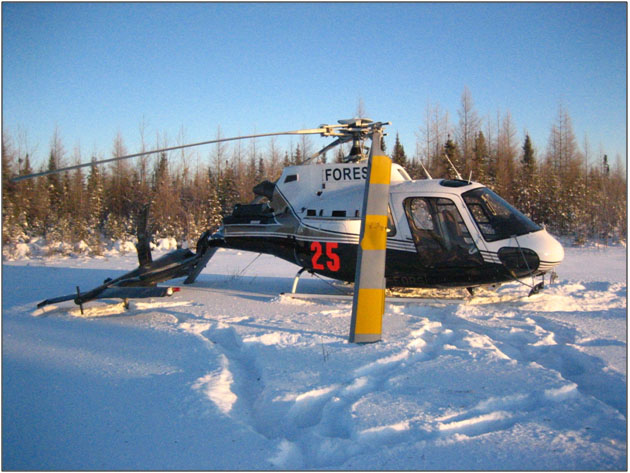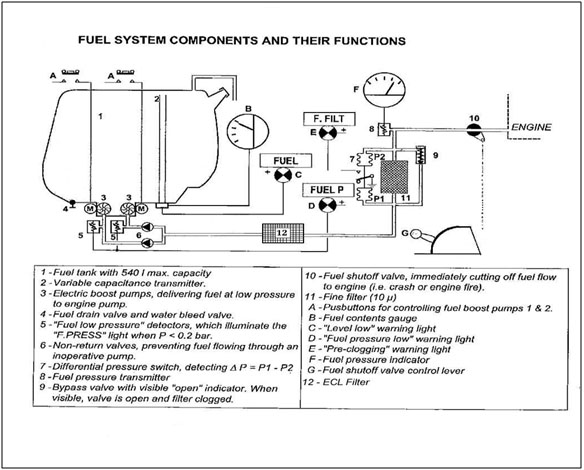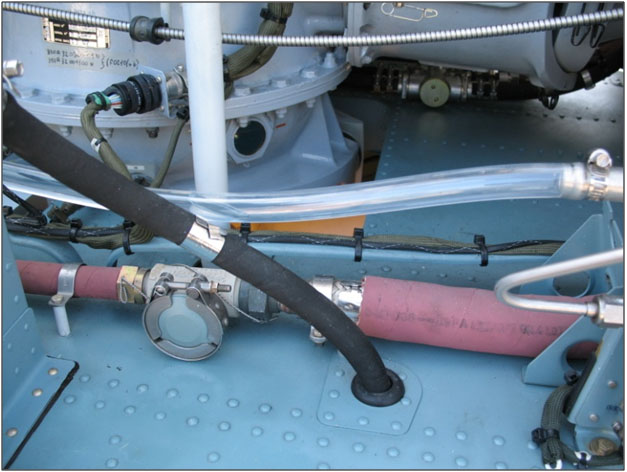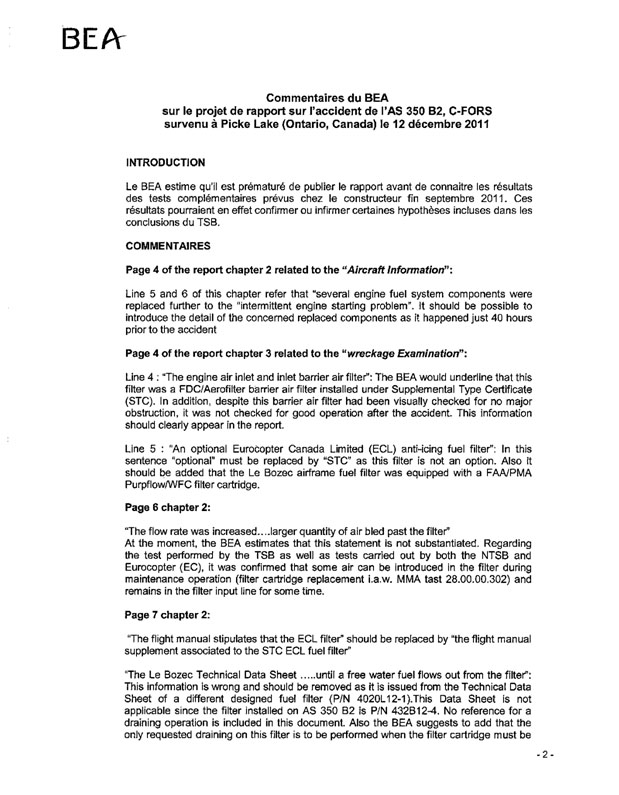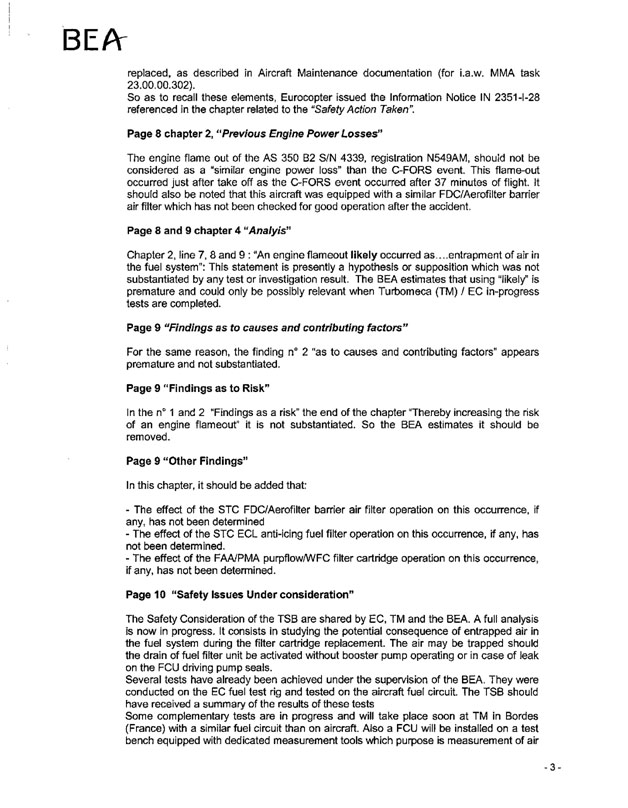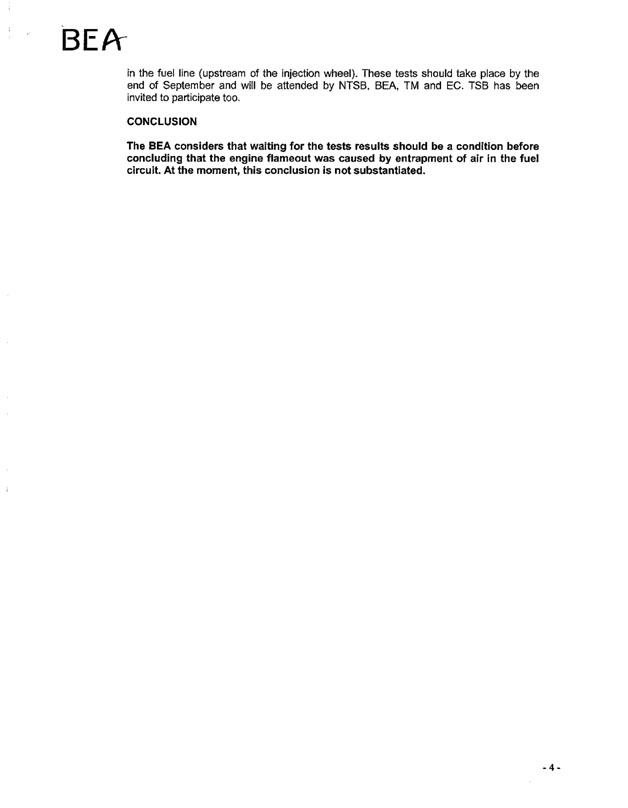Engine Power Loss and Autorotative Landing
Forest Helicopters Inc.
Eurocopter AS 350 B2 (Helicopter), C–FORS
Pickle Lake, Ontario, 6 nm northeast
The Transportation Safety Board of Canada (TSB) investigated this occurrence for the purpose of advancing transportation safety. It is not the function of the Board to assign fault or determine civil or criminal liability. This report is not created for use in the context of legal, disciplinary or other proceedings. See Ownership and use of content. Masculine pronouns and position titles may be used to signify all genders to comply with the Canadian Transportation Accident Investigation and Safety Board Act (S.C. 1989, c. 3).
Summary
On 12 December 2010, during daylight hours, the Forest Helicopters Inc. Eurocopter AS 350 B2 helicopter (registration C–FORS, serial number 4001) was conducting slinging operations approximately 6 nautical miles northeast of the Pickle Lake Airport, Ontario. The pilot had picked up a load of fuel barrels with a longline and was transitioning into forward flight. At low airspeed, and approximately 250 feet above ground level, the helicopter’s engine lost power. The pilot jettisoned the load and attempted an autorotative landing. The helicopter struck the ground in a level attitude and one of the main rotor blades severed the helicopter's tail boom. The pilot was not injured and was able to exit the aircraft without assistance. The helicopter was substantially damaged. There was no post‑crash fire and the emergency locator transmitter did not activate. The accident occurred at 0800 Central Standard Time.
Factual information
History of flight
The Eurocopter AS 350 B2 helicopter (helicopter) was being operated in support of mining operations from a staging area located approximately 6 nautical miles (nm) northeast of the Pickle Lake Airport (CYPL). When not in use, the helicopter remained outside at the staging area. The helicopter was equipped with winter covers for both the rotor head and engine and transmission area, along with portable electric heaters. On the morning of the occurrence, the pilot removed the winter covers and electric heaters and prepared the helicopter for use. The pilot conducted a visual inspection of the helicopter. No precipitation had fallen overnight and the helicopter was free of contamination.
The pilot had fuelled the helicopter the day before to approximately 50% of its maximum fuel capacity, Footnote 1 sufficient for the planned morning flights. The helicopter flight manual’s cold weather operation section, states: “Do not bleed the fuel system under a temperature equal to or lower than −10°C where valve seals prove inefficient.” The morning of the occurrence, the ambient temperature was -29°C and the fuel system was not drained.
The pilot started the helicopter, and after a normal start and warm up, loaded the drill crew and flew to the first drill site located approximately 1.4 nm to the northwest of the staging area. The pilot dropped off the first drill crew and continued on to the second drill site located approximately 2.4 nm northeast. The pilot dropped off the second drill crew and returned to the first drill site to pick up the first drill crew. The pilot then returned to the staging area to drop off the first drill crew and pick up 3 fuel barrels, which were to be moved to a cache site. The fuel barrels had been placed in slings and a 100–foot longline was positioned on the ground in preparation for the move. After the first drill crew had disembarked, one of the drill crew members hooked the longline to the helicopter. The pilot then moved the helicopter closer to the fuel drums and the drill crew member hooked the longline to the drum slings.
The staging area was surrounded by 70–foot trees. The pilot began a vertical lift with the 3 barrels in order to clear the trees. Once the barrels were above the trees, the pilot began to transition into forward flight. At approximately 250 feet above ground level, with approximately 40 knots forward airspeed, the engine suddenly began to spool down. The engine gas generator speed (Ng) and main rotor speed (Nr) gauges rapidly decreased. The pilot immediately lowered the collective control, applied a forward cyclic control input to gain airspeed, and released the slung load.
The helicopter descended rapidly and just prior to ground contact, the pilot raised the nose of the helicopter to reduce forward speed and attempted to run the tail stinger on the ground to slow the descent and reduce the impact force. The helicopter struck the ground with some forward momentum. As a result of the impact, one of the main rotor blades struck and severed the tail boom (see Photo 1). The helicopter remained upright and slid forward approximately 60 feet before coming to rest. The emergency locator transmitter (ELT) did not activate as the deceleration forces were less than those required to activate its internal multi–axis g–switches. The pilot, who was wearing a 4–point harness and helmet, was able to exit the aircraft uninjured. The Arriel 1D1 engine had stopped running by the time the helicopter made contact with the ground. The engine had been running continuously from initial start–up until it lost power. The total flight time was approximately 37 minutes. There were no abnormal engine or cockpit indications prior to the engine power loss.
Pilot information
Records indicate that the pilot was certified and qualified for the flight in accordance with existing regulations. The pilot held a commercial helicopter pilot licence valid for daylight visual flight rules and a category 1 medical certificate valid until 01 March 2011. The pilot had accumulated approximately 4100 total flight hours prior to the occurrence with approximately 1100 flight hours on the accident aircraft type. There was nothing found to indicate that the pilot’s performance was degraded by physiological factors.
Weather
The 0800 Footnote 2 aviation routine weather report for CYPL was as follows: wind 280° true at 3 knots, visibility 15 statute miles with clear skies, temperature −29°C, dew point −33°C, and altimeter setting 30.33 inches of mercury.
Aircraft information
Records indicate that the helicopter was certified, equipped, and maintained in accordance with existing regulations and approved procedures. The total time on airframe was 3412.8 hours and the total time on the engine was 1278.9 hours. On 22 October 2010, the helicopter underwent a 100–hour inspection, approximately 40 flight hours prior to the occurrence. The helicopter had been experiencing an intermittent engine starting problem and several engine fuel system components were replaced. On 07 September 2010, the fuel pressurizing valve was replaced.
On 22 October 2010, the ignition box and start drain valve were replaced. On 23 October 2010, the start injector electro–valve and ignition cables were replaced and the start injectors were re‑shimmed. On 29 November 2010, approximately 10 hours prior to the occurrence, the hard starting problem continued and fuel was noted coming from the fuel control unit’s (FCU) overboard drain line during system purge with the boost pumps on. However, the leakage stopped when the engine was running. The overboard leakage was within acceptable limits but the FCU was replaced with a rental unit to troubleshoot the starting issue.
The installation of the rental FCU did not fix the starting problem, and the original FCU was reinstalled. Subsequently, the engine start injectors were replaced and the engine start problem seemed to be resolved. An auto–ignition system is not available for this engine, nor is it required by regulation.
Wreckage examination
The helicopter was removed from the site and transported to the operator’s base in Kenora for examination. The helicopter was kept outside in below–freezing temperatures until it could be examined by a team consisting of representatives from the TSB, the operator, and the engine and airframe manufacturers. The engine air inlet and inlet FDC/Aerofilter barrier air filter (installed under Supplemental Type Certificate (STC) SR00811SE) were examined and found to be free of major obstruction. Other than the visual examination, no further testing of the filter was conducted. Part of the FDC/Aerofilter STC included the installation of an engine alternate air door and a low inlet pressure warning light system. The warning light is designed to illuminate if a filter blockage occurs. The low inlet pressure warning system was tested and found to operate normally. There was no indication that the light had illuminated during the occurrence.
The helicopter was equipped with a Eurocopter Canada Limited (ECL) STC anti–icing fuel filter and the standard Le Bozec airframe fuel filter equipped with a FAA/PMA Puroflow/WFC filter cartridge. The fuel system was examined and no restrictions or contamination were found in the fuel tank, fuel lines, or inline fuel filters. The fuel level was determined to be about 40%. The fuel shutoff lever was witness–wired in the open position. The fuel control lever was in the Stop detent position, where it had been moved by the pilot prior to leaving the helicopter. The engine throttle, fuel control lever, anticipator and engine FCU rigging were checked. There were no anomalies noted. Both fuel pumps were tested and operated normally.
A pressure test of the system was carried out with no leaks present. Fuel samples were taken and were found to be clear and bright. The fuel was subsequently tested and found to meet the Jet A–1 specifications for density, flash point, water content, freezing point and distillation properties. The effects of the cold weather operation on the occurrence, if any, could not be determined.
The engine and engine fuel control components were removed from the helicopter and taken to the engine manufacturer’s facility in Grand Prairie, Texas, for testing and examination. The engine was installed on a test bed and run successfully. The engine met all performance criteria with no anomalies noted. The engine fuel control unit, start solenoid valve, start drain valve, main drain valve and pressurizing valve were removed from the engine and bench checked. No faults were found that would have resulted in an engine flameout.Footnote 3 The fuel control unit was disassembled and no internal anomalies were noted.
Fuel system testing
The helicopter was re–examined and the complete airframe fuel system was removed and taken to the TSB Central Region wreckage examination facility for further examination and testing (see Figure 1). For test purposes, the fuel lines were changed with clear plastic lines of the same internal diameter to allow for an unobstructed view of the fuel flow through the system.
A valve was positioned aft of the firewall fuel shut–off valve to simulate fuel purge and flight conditions. The purge, cruise and maximum power flow rates were obtained from data acquired through testing of the engine and engine fuel components at the Turbomeca facility in Grand Prairie, Texas. A variable DC power supply was used to power the electric fuel boost pumps.
The airframe fuel filters were removed and reinstalled to simulate servicing of the fuel system. The boost pumps were turned on and the fuel system was bled in accordance with instructions contained in the Aircraft Maintenance Manual (MM), Section 28.00.00.302. The fuel flow was set to the purge flow rate and once the flow stabilized, the pumps were shut off. A large quantity of air that had not been bled out of the system during the purge event remained in the line, between the 2 fuel filters. The flow rate was increased to the cruise and maximum power settings and air slowly bled past the fuel filters. With rapid flow adjustments, larger quantities of air bled past the filters.
The test was carried out for 37 minutes to simulate the occurrence flight. At the end of the test, a small quantity of air was observed in the fuel line upstream of the Le Bozec airframe filter.
On–ship testing
On–ship testing was carried out on another company helicopter equipped with the same fuel system configuration as the occurrence helicopter. The fuel line connecting the ECL filter to the Le Bozec filter was removed and replaced with clear plastic tubing to allow for a view of the fuel flow through the system. The airframe fuel filters were removed and reinstalled. Then, the system was bled in accordance with MM, Section 28.00.00.302. After these procedures were completed, the same quantity of air was observed in the fuel line as was found during the tests conducted on the occurrence aircraft’s fuel system.
In preparation for an engine run, the boost pumps were turned on for 30 seconds, as per Section 4, Normal Procedures, in the Rotorcraft Flight Manual (RFM), before the start button was pressed to facilitate purging of the FCU. The engine started normally and after the Ng stabilized, the fuel pumps were shut off in accordance with MM, Section 28.00.00.301 which requires that fuel system testing be done after maintenance work to ensure that no engine flameout or instability occurs, which could indicate that some air was drawn into the fuel system.
With the boost pumps OFF, air was rapidly and sporadically drawn out of the ECL filter. This air entered the Le Bozec filter. Some minor engine surging occurred, but the engine continued to run. After approximately 2 minutes, the pumps were turned back ON and the engine regained smooth operation. The engine was run for another 3 minutes with the fuel flow control lever in the flight detent position. No abnormal indications were noted and flight would normally be initiated at this time. However, the engine was shutdown at that point. During the later stages of engine spool down, a small bubble of air appeared at the inlet of the Le Bozec filter. After the engine came to a complete stop, the fuel pumps were shut off. The bubble of air was then rapidly drawn back out of the Le Bozec filter inlet until approximately 8 inches of air was visible in the line (see Appendix A).
Air introduction
The fuel boost pumps are equipped with check valves that incorporate bleed ports to allow for pressure in the fuel lines to be bled off after engine shutdown. If the fuel system is opened, such as during filter servicing, air can be drawn into the system as fuel is returned to the tank by gravity through the check valve bleed port.
Testing also showed that air can enter the system if the fuel filters are drained with the boost pumps off. The flight manual supplement associated with the STC ECL fuel filter stipulates that the ECL filter is to be drained with the boost pumps on. When the ECL filter was drained with the boost pumps on during testing, air was not drawn into the system. In the case of the Le Bozec filter, the RFM and maintenance manual make no reference to a daily draining procedure.
The Component Maintenance Manual for the Le Bozec P/N 432B12–4 filter references draining the water at the bottom of the filter bowl by the hand operated drain valve when the flow of the fuel is stopped. Consultation with industry personnel shows that there are varying views on the draining practice for this filter.Footnote 4 Some operators drain the filter on a daily, pre–flight basis, with the boost pumps on, others drain it with the boost pumps off, and some do not drain the filter at all.
The third way that air can enter the fuel system is past a leaking FCU NTLFootnote 5 or Ng drive fuel‑pump seal. Following this occurrence, hard starting problems were encountered on another company helicopter. While troubleshooting, fuel leakage was noted coming out of the FCU overboard drain line during system purge. This fuel leakage is similar to what was experienced on C–FORS prior to the occurrence.
The source of the leak was believed to be either the FCU NTL or Ng drive fuel–pump seal. When stationary, air was being drawn through the FCU drain lines by the reverse flow of fuel, and back to the aircraft fuel tank. The fuel pump check valves were replaced with non–return valves. This stopped the reverse fuel flow and air from being drawn into the fuel system. The hard starting problems did not recur.
Engine flameouts
The engine’s ignition system is only in operation during the starting sequence. Once started, combustion is continuous and self–sustaining as long as the engine is supplied with the proper fuel–to–air ratio. If the rich limit of the fuel–to–air ratio is exceeded in the combustion chamber, the flame will extinguish. This condition is referred to as a rich flameout. It generally results from very fast engine acceleration, where an overly rich mixture causes the fuel temperature to drop below the combustion temperature. It also may be caused by insufficient airflow to support combustion, which may occur as a result of a blocked engine inlet or inlet filter.
An interruption of the fuel supply can also cause an engine to flame out. This may be due to prolonged unusual attitudes, a malfunctioning fuel control system, and blocked fuel supply, air introduction into the fuel delivery system, turbulence, icing or fuel exhaustion.
The Arriel 1D1 engine is not equipped with an auto–ignition system, so if a flameout occurs, the engine will not automatically restart.
Previous engine power losses
On 19 December 2010, concurrent with this investigation, the National Transportation Safety Board (NTSB) began an investigation of an AS 350 B2 helicopter (registration N549AM, serial number 4339) that had an engine power loss event in LaMonte, Missouri, USA (NTSB Accident No. CEN11LA118). The information surrounding the 2 occurrences was shared between the TSB and NTSB to facilitate common testing. In that occurrence, the Turbomeca Arriel 1D1 engine was run with no anomalies noted. The fuel systems of the 2 accident helicopters are identical with the exception of the ECL anti–ice filter. Testing of the fuel system carried out in support of the NTSB investigation produced similar results in regards to air introduction and difficulty associated with purging the system of air.
In order to address difficulties reproducing reported power loss events, the manufacturer had previously developed a troubleshooting checklist for operators to follow in the event of a power loss. That checklist was issued by Turbomeca, on 08 June 2005, as service letter 2338/05/AR1D/68, titled, “In–flight engine power loss”.
On 01 January 2009, Eurocopter issued technical support document 2030–I–00. This document, which was produced as a result of cases of engine flameout or damage occurring shortly after take–off, outlined precautions to follow when conducting cold weather operations in snow or rain.
The following TSB Laboratory report was completed:
LP 198/2010 – Fuel Analysis
This report is available from the Transportation Safety Board of Canada upon request.
Analysis
Testing of the engine and its fuel system could not identify a mechanical reason for the engine power loss. A blockage in the air inlet or fuel delivery system could cause an engine to flame out, but no such blockage or contamination was noted. Testing of the fuel system showed that air can become entrapped in the fuel system which could not be bled out by normal maintenance action prior to flight. The analysis will therefore examine the role that air entrapment may have played in this occurrence.
The investigation determined that air can be introduced into the fuel system through either a leaking FCU NTL or Ng drive fuel–pump seal, routine maintenance of the fuel system, or by draining the fuel filters with the boost pumps off. In this occurrence, the likely source of the air was a leaking FCU NTL or Ng drive fuel–pump seal which was identified during the hard start troubleshooting problems approximately 10 hours prior to the occurrence. However, the significance of this leakage, in combination with fuel boost pump check valves that incorporate bleed ports, was unknown at the time of the troubleshooting and the FCU was reinstalled on the helicopter.
An engine flameout likely occurred as a result of an interruption in fuel flow due to the entrapment of air in the fuel system. In response to the engine power loss, the pilot attempted to carry out an autorotation to the ground. However, the engine power loss occurred at an altitude from which a safe landing was not assured.
Some operators have adopted the informal practice of draining the Le Bozec airframe filter with the boost pumps off. The RFM and MM make no reference to a daily draining procedure for the Le Bozec airframe filter. On helicopters equipped with boost pump check valves that incorporate bleed ports, the practice of draining the Le Bozec fuel filter with the boost pumps off may inadvertently introduce air into the aircraft’s fuel system.
The Arriel 1D1 engine is not equipped with an auto–ignition system, nor is it required by regulation. On helicopters without an auto–ignition system, if a flameout occurs, there may be insufficient time to attempt an engine relight.
Findings
Findings as to causes and contributing factors
- A leaking FCU NTL or Ng drive fuel–pump seal, in combination with fuel boost pump check valves that incorporate bleed ports, likely allowed air to be introduced into the fuel system.
- The engine lost power, likely as a result of a flameout caused by an interruption in fuel flow due to entrapment of air in the fuel system.
- The engine power loss occurred at an altitude from which a safe landing was not assured.
- On helicopters equipped with boost pump check valves that incorporate bleed ports, the practice of draining the Le Bozec fuel filter with the boost pumps off may inadvertently introduce air into the aircraft’s fuel system, thereby increasing the risk of an engine flameout.
- After routine fuel filter maintenance, the fuel system bleeding procedure does not ensure the system is completely purged of air, thereby increasing the risk of an engine flameout.
- The Arriel 1D1 engine is not equipped with an auto–ignition system. Therefore, if a flameout occurs there may be insufficient time to attempt an engine relight.
Other findings
- The effects of the cold weather operation on the occurrence, if any, could not be determined.
- Limited testing did not establish that the FDC/Aerofilter barrier air filter, ECL anti–icing fuel filter, or FAA/PMA fuel filter cartridge had any adverse effect on the operation of the engine in this occurrence.
Safety action taken
Due to similarities between this occurrence and the concurrent NTSB investigation, Eurocopter France initiated a test program to see if air that had been introduced into the fuel system could result in engine operating difficulties. The tests were conducted in conjunction with the engine manufacturer Turbomeca, the airframe filter manufacturer Le Bozec and the French accident investigation bureau BEA (Bureau d’Enquêtes et d’Analyses). The tests were initiated in the spring of 2011with further testing of the airframe fuel filter conducted in the fall of 2011. Testing of the engine for air ingestion is planned for late 2011 with a full analysis in progress.
On 26 July 2011 Eurocopter released Information Notice No. 2351–I–28 informing operators of AS350 B, BA, BB, B1, B2 and D models of the possibility of air being introduced in the fuel system by activating the drain located at the bottom of the airframe filter unit assembly. Eurocopter reminded operators that the drainage of the fuel filter is not required in daily operation. However if draining is to be performed, it must be performed with at least one of the two booster pumps operating to prevent air from being drawn into the system
Turbomeca has developed a design improvement of both the FCU NTL and Ng seals, with a NTL seal replacement in the field by the end of 2011 and a planned introduction date of the Ng seal by the end of 2012.
This report concludes the Transportation Safety Board's investigation into this occurrence. Consequently, the Board authorized the release of this report on .
